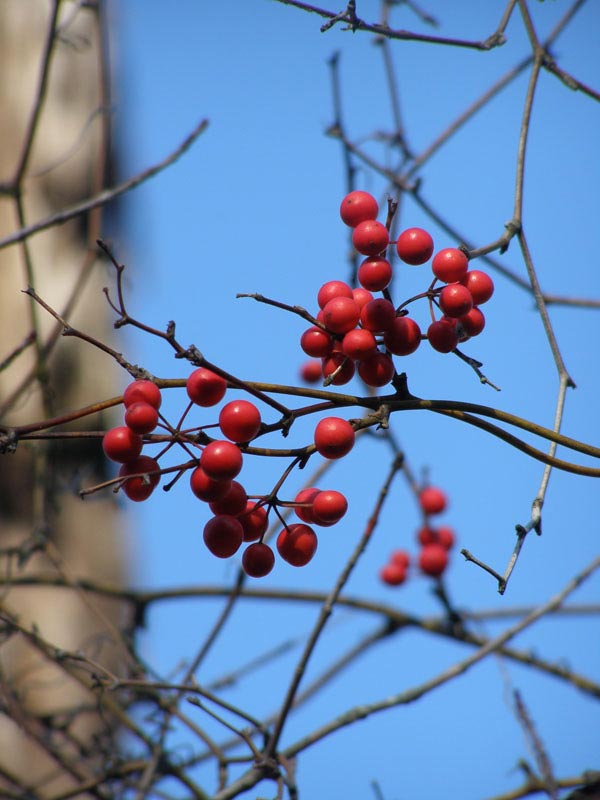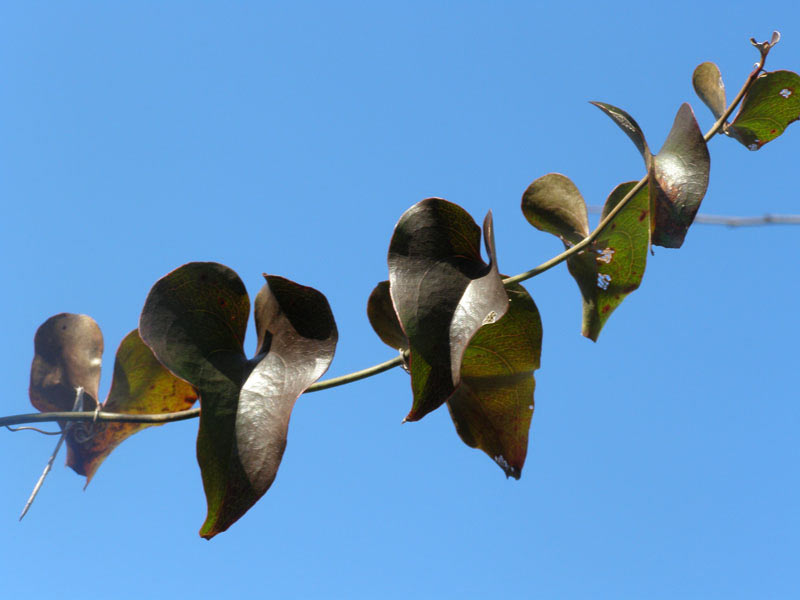More red berries!

The brilliant red of Red-berried Swamp Smilax adorns bare tree branches in swampy sites. Photo by Ken Moore
By Ken Moore
Flora Columnist
If you are expert at using your “owl eyes†while driving, you may spot some red berries that are neither holly nor dogwood. Like holiday lights, these red berries are strung up in tangles and thickets. I’m describing the fruit of one of the species of catbrier, Smilax sp., that folks curse when they encounter them in the wild.
Most of the Smilax species bear round clusters of black fruit. One of them, the Coral Greenbrier, or Red-berried Swamp Smilax, Smilax walteri, sports brilliant red berries. Unlike the Common Greenbrier, Smilax rotundifolia, and Catbrier, Smilax bona-nox, this red-berried Smilax is most commonly found in the standing waters of the bogs and swamps of the Sandhills and coastal plain. Rarely will you spot it in our eastern Piedmont.
However, there is a place to view it not far from Carrboro and Chapel Hill. Drive on NC 54, just a short ways east of Interstate 40 to the limited parking space at the New Hope River Waterfowl Impoundment sign. Be certain to take your binoculars with you. Walk back, being constantly mindful of the traffic, along the north side of the road, to look out over that swampy area of standing water. Here and there you will observe clusters of brilliant red berries scrambling over the trees and shrubs. In addition to viewing birds, I frequently use my binoculars for close-up views of plants. I promise, you will be impressed with a close-up view of those red catbrier berries. You’re not otherwise likely to get very close to those vines in the water, unless, of course, you’re wearing waders.
For years, I have wanted to have a Red-berried Catbrier in my own garden. I know of no nursery that offers it – and if ever plants are available, one will have to plant several in hopes that one of them will be a female vine that will produce the red berries if pollinated by a close-by male. If I can get my hands on some berries, I sow some seed myself!
I do have several of the common black-berried catbriers with semi-evergreen leaves volunteering on trellises along my deck. In the winter months, the foliage takes on burgundy tints and is effective woven into seasonal wreaths. Like my volunteers, many catbriers are thorn-free, so we need not curse them. I value my catbriers because they are drought tolerant, and cut branches are effective in flower arrangements any time of the year. Many an old Southern farmhouse porch and garden arbor have been well shaded by the use of one or more of the evergreen species of catbrier.
More important than their aesthetic value, Smilax fruit, leaves and stems are valuable wildlife foods for many species of birds and mammals, including the black bear. Native-American ethno-botany references describe countless medicinal, culinary and other uses, including grinding tubers for making bread, using stems and leaves for herbal teas and salves, use of the thorns as a type of acupuncture, tying thorny vines together for protective barriers and using vines in basket making, a rich heritage indeed.
During the next week or so, make a little field excursion down to New Hope Swamp to view those red berries before the birds and other critters make a meal of them. While there, see if you can spot some of the red hips of the swamp roses, Rosa palustris, also growing in the standing water. You can get close to some of those without getting wet.
Email Ken Moore at flora@carrborocitizen.com. Find previous Ken Moore Citizen columns at The Annotated Flora (carrborocitizen.com/flora).



Comments are closed.